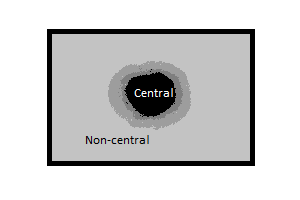
Let's review one of the more complex ideas that can help in playing poker.
Imagine that the given rectangle is a poker map. This map shows a multitude of probabilities, and each point on it represents a possible sequence of poker hands.
The dark center shows what happens with 99% of most hands in poker. But you must have noticed that it does not cover 99% of the rectangle's area. This is because the dark spot shows not 99% of all possibilities, but 99% of the possibilities determined by frequency. If we listed all the possible hands that can be played in poker, the range would be astronomically large. But listing 99% of the most common probabilities, their number will be much smaller.
Partly, this is because most hands are played out in the early stages and are therefore less complex. Also, this is because a large portion of hands is very simple and essentially plays “itself” – either by making a c-bet, or after the flop, the hand becomes so good/bad that the decision is clear by itself.
So, we can think of this scheme as a probability map – the highest probability is represented by dark colors, the lowest by light colors. The remaining parts of the map are complex or unusual situations, marked in light gray, and these situations happen rarely. Most poker situations fall within the 99% circle.
This entire map illustrates the idea of centrality. Centrality is essentially a measure of how common a certain thing is. In terms of this diagram, it would mean how close to the center our poker action is. For example, a place that would be close to the center is light 3-betting before the flop. Such a decision is common during a session, and the fact that it is done often brings it closer to the center.
A place that would be completely far from the center would be similar to this: a 3-bet bluff shoving all-in on the river to represent a runner-runner straight caught on the river. Such a situation occurs less than once in 2000 hands.
An important difference between the circle in the center and a place far from the center
Any place near the center will be much simpler than one far from it. If a point is close to the center, it means every player has encountered it so many times that they understand its dynamics quite clearly. On the other hand, in places that are far from the center, people more often make poker mistakes, as they have very little experience.
The conclusion of the centrality idea: people will only master what they need to master. You can think of it as natural selection in poker. This means that if your opponent has never had good skills in complex situations or performing certain actions, they won't have them. People develop only those habits that are necessary for them, and no more.
For example, six years ago, light 3-betting was an extremely powerful strategy because it was very far from the center (rare). A few people gained experience with such a situation and learned to handle it. Until then, poker players had no need to understand how to deal with this situation, so they didn't think about it. But now, after six years, such a situation can be encountered daily.
The truth is that the game before the flop is quite simple. Since it defines the game only in the early stages, which are completely simple. This leaves little room for complexity, maneuvering, mistakes, and exploitation. If you focus on preflop play, you will earn little money because its situations are very simple and many people encounter them, such play is at the very center of the map and many understand it well.
So, there are two important observations from the map we examined. First, if your poker game consists of actions close to the center, you reduce your chances of exploiting the opponent, as you allow them to stay in a zone they understand well. Second, by leading them into territory far from the center where they are not very skilled, you allow them to make more mistakes. This is why players who have a very unusual playing style, even one that sometimes seems poor, sometimes win the most. Their success can be explained by the fact that such players like to push the opponent out of the centered and clear playing zone, while they themselves remain in the center of the circle.





